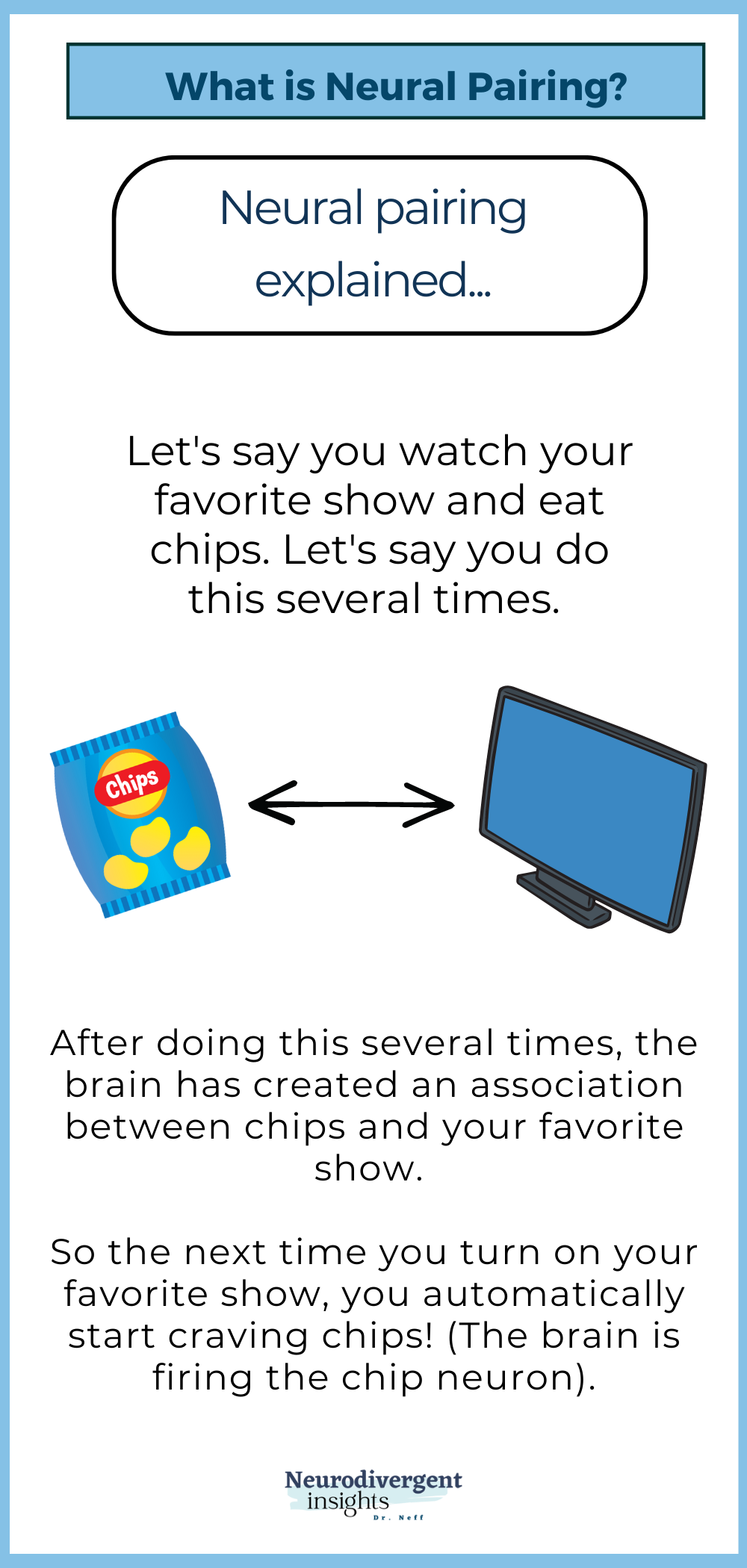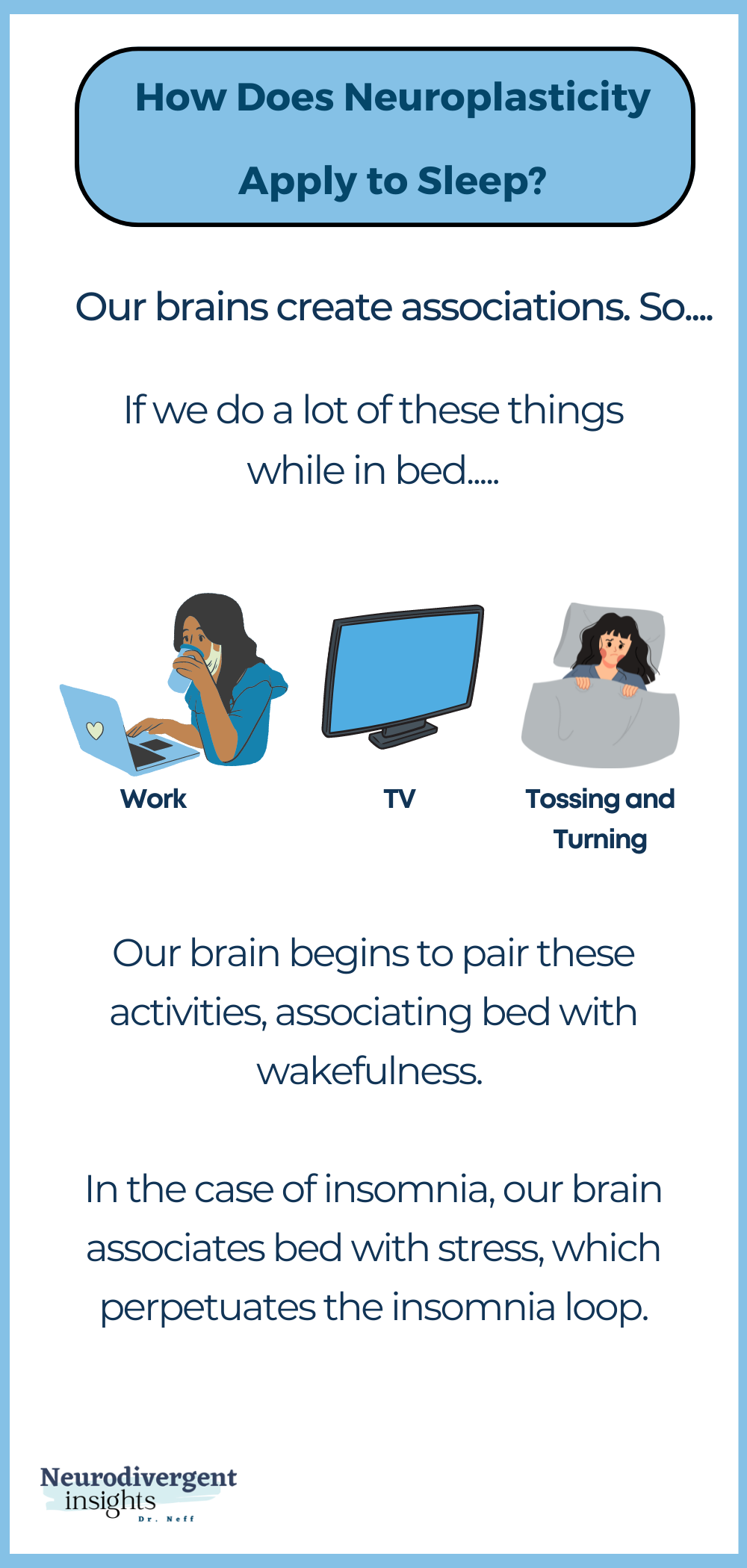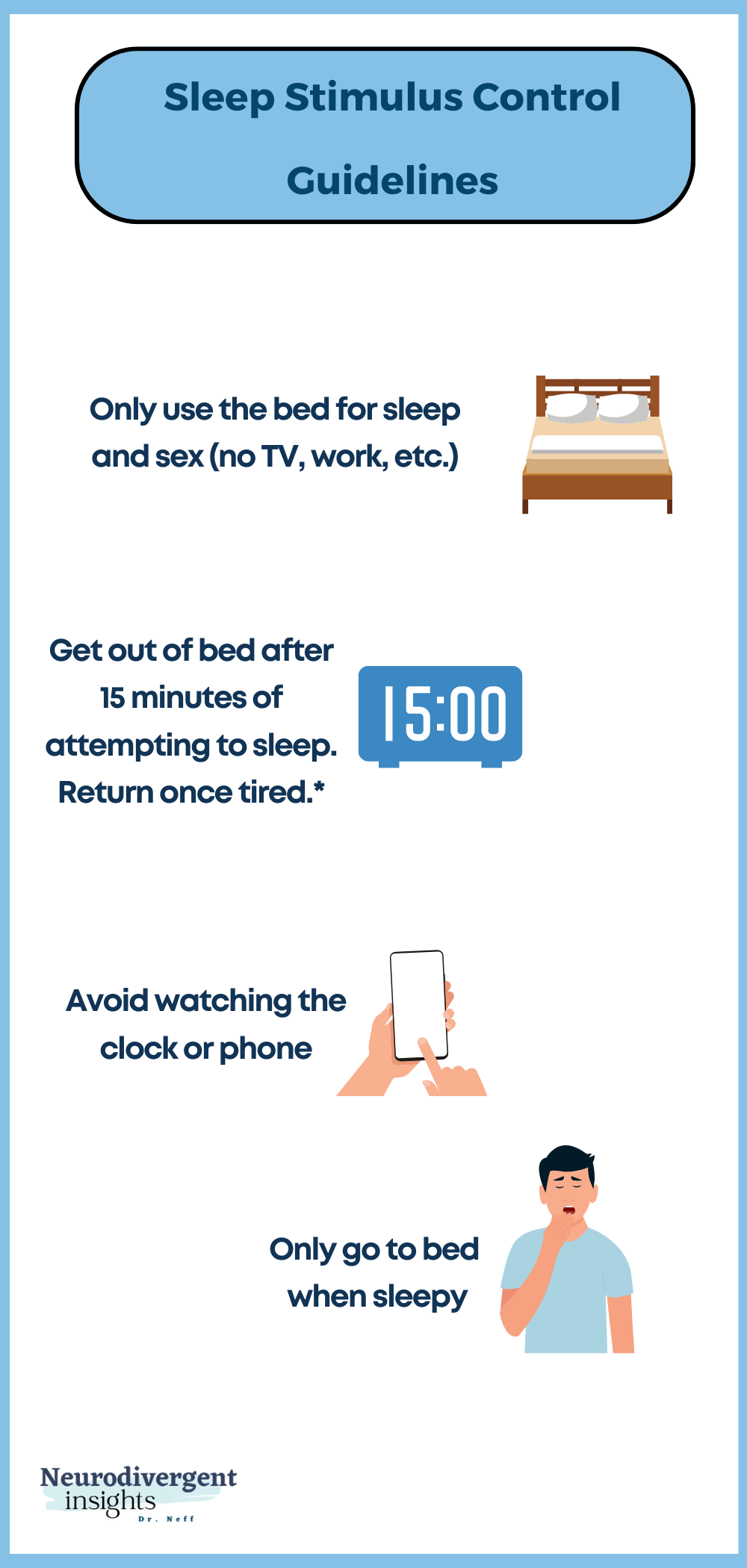Sleep Stimulus and Neuroplasticity: Learn to Get Better Sleep
If you’re struggling with getting good sleep at night, there’s a good chance that sleep stimulus control can make a huge difference for you. As both someone who has struggled with sleep issues and as a clinician who has worked with clients struggling with their sleep, I understand the impact poor sleep can have on every aspect of your life. In healing my own sleep patterns and helping my clients heal theirs, I have come to understand that sleep stimulus control is a very important component to getting better sleep.
Because I work with Autists and ADHDers, this sleep stimulus article will be tailored to the neurodivergent experience. If you are not neurodivergent, this article is still for you and will provide you with useful sleep stimulus information. If you are neurodivergent, this article will be especially helpful for you.
Neurodivergence and sleep issues often go hand in hand. We are predisposed to things like insomnia, genetic conditions that affect our sleep, circadian rhythm disorders, and more. If you want more information about neurodivergence and sleep, check out my article on ADHD, Autism, and Sleep. Not only is there a lot more information in the article, but there are loads more tools and resources tailored to you to help you get better sleep at night.
In this article, I will discuss neuroplasticity and it’s role in our sleep cycle, sleep stimulus, the Sleep Stimulus Control Protocol, and the 15-Minute Rule. Let’s get into it:
What is Neuroplasticity?
Before we dive into learning about sleep stimulus, it’s important to understand neuroplasticity and how it can help us get better sleep. Neuroplasticity refers to the brain’s ability to create new neuropathways.
Principle One: The Brain is Adaptable
To understand neuroplasticity, it’s helpful to first break down the word. Neuro means brain, and plastic refers to flexibility and adaptability. Put together; neuroplasticity is a fancy way of saying our brains are incredibly adaptable and constantly evolving to adapt to our environment. Our brains are constantly observing what is happening in our environment and responding.
Principle Two: The Brain is Looking For Connections!
Every day we need to make thousands of decisions. The brain could simply not keep up if all of these decisions required conscious effort! For this reason, the brain loves to form habits and associations. With the help of habits and associations, many of the decisions we make happen on autopilot.
Neural associations create a sort of shortcut for the brain where it simply doesn’t have to think about it (it’s on auto-drive!). Our brains are really good at creating neural pairings or neural networks. This can both work for or against us. This get’s us to principle three: the brain is filled with these neural associations!
Principle Three: The Brain is Filled With Associations!
The brain is an intricate web of neural networks and associations. Every time we experience an incoming sensation (touch, smell, memory, thought, taste), it is connected with hundreds of other neurons and activates a whole neural network. But let’s keep it simple and look at neural pairing. Neural pairing refers to whenever any two neurons are paired together. When this happens, if one neuron is triggered, it triggers the other. Let’s look at food as an example, as food is commonly paired with other things (for example, birthday cake and birthdays, champagne and celebration).
Let's say you watch your favorite show and eat chips. Let's say you do this several times. Over time your brain begins to associate these two activities, and before you know it whenever you sit down to watch your favorite show, you are craving chips!
You can likely imagine how this can both be a helpful thing and a harmful thing. We may begin to create associations that lead to addiction and disordered use of substances, food, and more. On the flip side, associations can also promote health (for example, associating mornings with walks and smoothies or associating dinner with veggies). Neural associations can both work for us and against us.
Principle Four: Neural Connections Strengthen Over Time!
Imagine a trail in the woods. You walk the trail everyday and every time the trail becomes more defined. Now imagine you decide it would be better if the path went a different way through the woods. When you walk this new path for the first time, it’ll be difficult because there’s no path there yet—you’re creating it! However, you only walk down this new path, and everyday it becomes more and more defined. And, as you ignore the old path, it gets less and less defined. Eventually, you won’t be able to see it anymore.
Our brains work in a similar way. As we learn and live, we are always creating new neuropathways, some for the better and some for the worse. Many of these include overcouplings and associations. When we discover neuropathways that are harmful to our health and well-being, we can change them, but it takes effort and intention.
How Does Neuroplasticity Relate to Sleep?
As discussed above, the brain is always creating associations. Our brain has hundreds of associations around sleep, the bed, our bedtime routine, and more. We can either make these associations work for us or work against us. If you have ever heard the advice: don’t do work or watch TV in bed, it’s because of neural associations. When we do these wakeful activities in bed, the brain begins to associate the bed with wakefulness, and when this happens, it becomes harder to fall asleep!
In general, as a society, we’ve started developing some pretty unhelpful neural pairings. For example, many of us have learned to associate our beds with watching tv or scrolling on TikTok for hours. Therefore, whenever we climb into bed, we get the craving to watch tv or scroll on our phones. This is harmful because these are wakeful and activating activities. So our beds no longer become a place of rest and relaxation but a place for these activating activities. This makes it harder for our body to relax enough to fall asleep at night.
But, because of our brain's neuroplasticity, we can rewire them to stop associating bed with wakefulness and begin associating bed with sleep. We can stop walking down the “wakefulness-in-bed path” and begin walking down the “restfulness-in-bed” path. So let’s take a deeper look into how all of this neuroplasticity information applies to sleep.
What is Sleep Stimulus Control?
To put it simply, stimulus refers to any signal that sends a message to the brain. Seeing a table set for dinner is a visual stimulus indicating it’s time to eat (there is also a smell stimulus reinforcing the message that it is time to eat). So when it comes to sleep, we are concerned about the sensory signals (visual, smells, sounds that either cue the body that it is time to sleep or wake).
Sleep stimulus control therapy, specifically, is concerned with influencing the stimulation we expose our minds and bodies to, in order to help us sleep better. Sleep stimulus control helps to break associations between bed and wakefulness by eliminating activating stimulation and reinforces associations between bed and sleep by supporting restful, regulating practices.
Sleep stimulus control is especially important for neurodivergent people to consider. Autists and ADHDers, on average, have a delayed onset of melatonin, the brain’s sleepy chemical. This means that if we are to fall asleep when we want to, our brains and bodies need a lot of priming. However, because we also tend to experience sleep issues like insomnia more so than neurotypical people, many of us have created harmful associations with bed and sleep.
For example, if you spend hours laying awake in bed trying to fall asleep with a lot of anxiety and a racing mind, then you may have created an association between bed and restlessness/anxiety. Sleep stimulus control helps us to create external signals to tell the brain and body that it’s time for sleep and to break those harmful associations.
Sleep Stimulus Control Protocol
The Sleep Stimulus Control Protocol is here to help you remove wakeful stimulation to weaken the bed = wakefulness association. Here’s how it goes:
Don’t watch the clock! If you’re having trouble falling asleep, try facing your clock away from the bed or turning your phone upside down
Avoid using your phone when you’re in bed. Whether it’s nighttime or the middle of the day, using a phone when you’re in bed will strengthen the bed = wakefulness association. So try to avoid it at all times.
Avoid sleeping in any other room. If you nap on the couch in the living room, for instance, this weakens the bed = sleep association. So if you take naps, take them in your bed.
Only use your bed for sleep and sex. If you like to read or work in your room, avoid doing so in your bed. It’s best if you find a different room entirely to do those things, but that is often not a possibility for many people.
Only go to bed when you’re sleepy. If you have trouble falling asleep at night, it’s best to only head to bed when you’re actually feeling tired. This will increase the chances of you falling asleep quickly and, therefore, strengthening the bed = sleep association.
15-Minute Rule Guidelines
The 15-Minute Rule is here to help strengthen the bed = sleep association. This is particularly useful for those with insomnia or who generally find it difficult to fall asleep and stay asleep. Here’s how to practice the 15-Minute Rule:
Go to bed when you’re sleepy. If you are not sleepy, wait to go to bed until you are.
If you are in bed for roughly fifteen minutes (guess, don’t watch the clock!) and you still haven’t fallen asleep, get up. This can be difficult, but it will help in the long run!
Do something relaxing until you feel sleepy again. Some examples of relaxing activities include reading, knitting, folding laundry, etc. Remember, try to avoid doing these activities in your bedroom (especially not in your bed!). It also helps to have these things set up before you go to bed, so they’re ready if you need to get up.
When you are sleepy again, repeat this process. Go to bed and if you’re still awake in 15 minutes, get up again.
If you get fixated on the clock or if this exercise causes anxiety, drop it. Instead, try CBT-I or relaxation exercises. You can find examples in this article.
If you have trouble with interoception (the ability to sense your body’s states of being), then you may find it difficult to know when you’re sleepy. If this is the case for you, I recommend trying some interoception exercises first. This article on interoception and kids may help.
**Dr. Neff note: The 15-minute rule is helpful because it minimizes the amount of time spent tossing and turning attempting to sleep. However, it takes ADHDers and Autistic people longer to fall asleep on average, so it may be better to use a 20 or 25-minute rule.
Conclusion: Sleep Stimulus
When we struggle with falling asleep, we can create many harmful associations with our beds and with sleep itself. These harmful associations can often make falling asleep much more difficult. Thankfully, because of our brain's ability to reshape itself and create new neuropathways, we have the tools and capacity to change those associations. By using sleep stimulus control practices—the Sleep Stimulus Control Protocol and 15-Minute Rule—we can weaken the bed = wakefulness associations and strengthen the bed = sleep ones.
If you are a neurodivergent person looking for more help with your sleep patterns, I have a Neurodivergent Sleep Guide designed to help Autistic and ADHD people get better sleep. In the workbook, you’ll find lots of information about the overlap between neurodivergence and sleep issues, loads of workbook pages to help you understand your own sleep patterns, and an abundance of resources.
This post was proofread by Grammarly, my go-to for proofreading and catching all the details I naturally miss! Grammarly is entirely free to use. Click here to give it a try.






